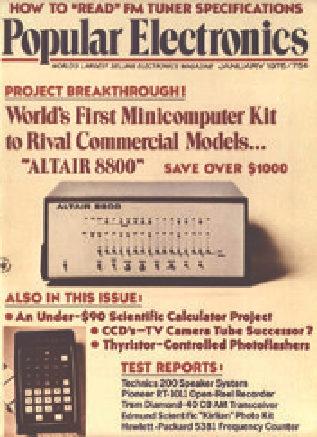Information Technology Reference
In-Depth Information
Fig. 8.3. Taylor and PARC scenes.
Clockwise from top left: Bob Taylor, Alan
Kay, the Dynabook, the pocket calcu-
lator, and
Rolling Stone
reporter Stewart
Brand drawing with a computer.
that's priced within reach of many households - the Altair 8800, with an
under $400 complete kit cost, including cabinet.
5
On the cover was a picture of the Altair 8800 computer, complete with flashing
lights. In actual fact, it was just a picture of an empty case: the first prototype
had gone missing in a shipment between Albuquerque and New York, and there
had not been time to assemble another machine and get it to New York before
the magazine's deadline. The Altair was the brainchild of Ed Roberts, a U.S. Air
Force electronics engineer, and his small electronics hobby-kit company called
Micro Instrumentation and Telemetry Systems (MITS), based in Albuquerque,
New Mexico (
Fig. 8.5
). His company had been one of the first to put a calculator
kit on the market, but by 1974 fully assembled calculators were selling for less
than the kit. To save the company, Roberts devised a totally new product - a com-
puter kit based around the latest 8080 microprocessor from Intel. This chip was
more powerful than its predecessor, the 8008, and, as historian Paul E. Ceruzzi
says, “[it] required only six instead of twenty supporting chips to make a func-
tional system.”
6
In his design Roberts introduced an “open bus architecture” to
allow for the addition of extra circuit boards. A
bus
is just a set of connections
linking all the major components of the machine, including the central proces-
sor, memory, and input/output (I/O) devices, in a standard way. The
bus architecture
makes it possible to customize the computer with circuit boards offering a spe-
cific functionality. If a user wants a better sound system, for example, he or she is
able simply to unplug the old sound card from the bus and plug in a new one.
MITS planned to produce and sell plug-in cards for
peripheral devices
, aux-
iliary devices that would connect to the computer, such as memory boards,
paper-tape readers, terminals, and printers. Making the bus design open was
Fig. 8.4. The launch of the Altair by
Popular
Electronics
in January 1975. This cover
featuring the MITS Altair 8800 excited
thousands of hobbyists eager to build their
own computers. Roberts had not finished
the design of the computer when editor
Les Solomon solicited the article. The mag-
azine chose the name Altair after the star.
The prototype machine sent by Ed Roberts
got lost in the mail and never arrived so
the magazine photographed an empty box
for the cover photo.


Search WWH ::

Custom Search